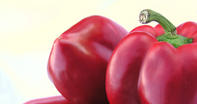
Scientific name: Capsicum Annuum
Common Names: Sweet Pepper or Bell Pepper
Plant Description
Sweet pepper is a tender plant with green oval shaped leaves that narrow to a pointy end. The pepper is a determinate plant that grows through its growing season then dies back after production of its fruit.
There are green, Red, yellow, white, purple, brown and orange pepper varieties. There are bell shaped peppers hence the name bell pepper, there are conical shaped peppers and smaller cherry peppers.
There are new indeterminate varieties, that can be pruned back, to produce new stems, leaves, flowers and produce new fruit continuously. They are mainly planted in greenhouses or warmer more temperate climates that allow for longer production periods.
Uses
Peppers are used in cooking to add flavour to other meat or vegetable dishes. They are eaten raw in salads and can be roasted and stuffed and baked with various fillings. They are said to have three times the vitamin C of an orange.Soil Requirements and Preparation
They require fertile sandy loam to loam soils that drain well. As the roots are concentrated in the top 30 cm of soil they are sensitive to both drought and water logged conditions. Irrigation needs to be very well managed.
There must be good humus in the soil or compost or organic material must be mixed into the soil prior to planting. The pH of the soil must be between 6.2 and 7.0. The closer to a neutral pH the better the peppers do.
Climate
Peppers are warm climate crops and are sensitive to frost and growth is severely retarded when temperatures drop below 15°C. They do best when day and night temperatures can fluctuate between 20°C and 30°C.
Once the fruit is starting to ripen it prefers dry weather without rain as this promotes fungus growth and irrigation management problems.
Cultivars
There are hundreds of cultivars but here are a few: California Wonder, King of the North, Jupiter, Pip, Chocolate Beauty, Keystone, Florida, Banana, Marconi Red, Ballito Sweet Golden, Cape Medallion Cherry and King Arthur.
There are new hybrids being developed and released regularly to capture unique attributes and strengthen resistance against pests and diseases. It is best to consult a seed cultivar specialist and agronomist in your area to assist in identifying the best cultivars for your unique climatic and soil conditions.
By Louise Brodie